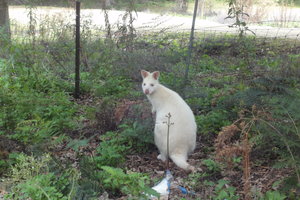Advertisement
Published: March 15th 2012

 The White Wallaby
The White Wallaby
We were lucky enough to see the white wallaby at the beginning of the trackOur last day in Tasmania and on Bruny Island. After such a relaxing day yesterday we had a lot more to see and do on the island today. After leaving the house we headed to the southern end of the island to the lighthouse and South Bruny National Park. On approaching the southern coast you look out to headlands and rocks with the lighthouse prominently shown on the southern cliff. We took the short walk from the carpark up the hill to the lighthouse which was commissioned in the 1820’s after numerous shipwrecks taking the passage into Hobart. It is now no longer used with an electric lighthouse setup on an adjacent hilltop. The viewing area at the lighthouse is spectacular looking out over the open sea, down steep cliffs and over sandy coves. We looked out for whales or dophins but saw nothing other than many seabirds feeding on shoals of fish.
The next stop was at Adventure Bay which appears to be the main town on the island. This bay is famous for the various explorers who have visited or sheltered here such as Bligh, Cook, D’Eastreaux and others I cannot remember.
We found a place along

 The lighthouse
The lighthouse
The decommissioned lighthouse at the south end of Bruny Islandthe beach to have our lunch then set out for the beginning of the Fluted Cape Walk. Before we started we were lucky enough to spy two white wallaby’s and get close enough to get some good photos. We then sensibly headed up the hill first rather than going around the coast. We expected to see snakes in the grass but despite keeping a keen eye out, saw none. The walk up was steep enough to get us hot and sweaty but on going down we realised that the other way was shorter but much more steep and slippery. The top was at 272m on top of columnar jointed rocks standing vertically from the sea upwards. The top rocks perch precariously atop each other looking ready to fall. These are reputed to be the highest cliffs in the southern hemisphere.
The track down is steep and slippery and follows the cliff tops until reaching a lower promontory where there are usually seals, penguins and sea birds. They had all left home for the day for we saw none.
Finally the track finishes along the rock strewn bay beach where whalers operated during the 1800’s. There were several information boards regarding the whaling stations and they did not make good reading. So many hundreds of whales were killed in the most gruesome way. At least it’s wonderful that this practice no longer occurs. The blubber was required for oil and cosmetics.
We caught the 4.30 ferry back to Kettering and drove to a bay near Kingston for dinner. Then finally back to Howrah for our last catchup with A&M. We caught up on each other’s news, said our many thankyou’s and set our alarms for a 4.00am get up for the airport.
Our visit to Tasmania was made all the better by being able to stay with A&M, enjoy their company and be guided by them on where to go. It is a very beautiful place with mountains to the west and amazingly gorgeous beaches to the east and south. Mostly I will remember it for the beauty of the coastline with it’s inlets, lagoons, bays, white sands, curved beaches, thundering seas on steep cliffs, empty interior and the never ending eucalyptes of one sort or another. Unfortunately we never got to sample the warmer north because of the accommodation problem nor were we able to get into the true mountains to the west, but, given that mountains are our usual destination on our travels this wasn’t an issue for us. The main tourist locations seem to be developed and catered for but other worthwhile places could do with further development. Tourism appears to be one of the main components of the Tasmanian economy and it seems that there is much that can be done to develop this further. Signposting isn’t great. Viewing and pull off areas are not abundant on the roads and often views are screened by trees that need cutting back. Lastly, the variety and availability of accommodation seems inadequate when comparing to that available in New Zealand. But, what wonderful opportunities there are to develop adventure and eco tourism much as we have at home. Maybe the fact that it hasn't been done fully to date is something to do with the sparse and laid back population?
Advertisement
Tot: 0.079s; Tpl: 0.012s; cc: 15; qc: 29; dbt: 0.05s; 1; m:domysql w:travelblog (10.17.0.13); sld: 1;
; mem: 1.1mb







